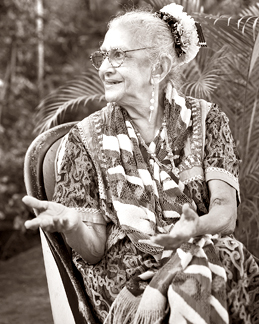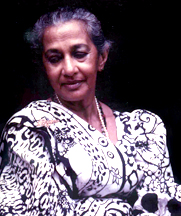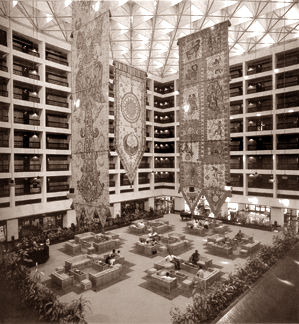The essence of Ena
The life and times of Ena de Silva, who celebrated
her 93rd birthday on October 23:
 |
|
Ena -
Photo: Dominic Sansoni |
Ena de Silva Aluwihare, born on October 23, 1922, was chosen to
appear as the Spirit of Lanka in 1948 in the Pageant of Lanka to
celebrate Independence. This foreshadowed her pioneering contribution to
the revitalization of a distinctive Sri Lankan heritage with regard to
architecture and related crafts in Sri Lanka.
In the early 60s, Ena de Silva requested Geoffrey Bawa to build a
house for her family. Not satisfied with the conventional houses of that
time, based on Western social concepts, she looked for something in line
with traditional Sri Lankan dwellings. Without similar precedence, the
house was inward looking and was built from wall to wall, with a large
central courtyard, and six others so that indoors and out blended
seamlessly throughout.
Two grinding stones support the entrance link, and led one through a
belled doorway from a Hindu kovil or shrine into the central courtyard,
with large circular oil presses in the corners, to sit or to dry spices.
Trees grew in the courtyards which opened directly onto rooms, and even
through roofs. One could sit, sleep or read a book in the trellised bay
windows.
The house was full of rich textures, and innovate details. For
perhaps the first time in independent Asia the dialectics of East and
West, inside and outside, as well as the traditional and the modern,
were truly transcended. The synthesis of Geoffrey Bawa as architect and
Ena De Silva as creative client provides a unique pioneering
collaboration in contemporary Asian architectural history.
Into Crafts
 |
|
Ena -
Photo: Stephen Champion |
Ena's longstanding interest in traditional craft came to full flower
after she moved into the Alfred Place house. Inspired in particular by
the 'somanas' or temple banners gifted to her by her husband Osmund de
Silva, she embarked on a career in design and production, working in
collaboration with highly original creative artists, notably Laki
Senenayake and her son Anil Gamini Jayasuriya. Her first flagship
creation was batik, and her designs in this art still remain the most
innovative and distinctively unique of all Sri Lankan batik. Her
creations in traditional embroidery, exotic cushion covers and dramatic
bedspreads, also continue to be immensely popular and unrivalled.
Her work hit Colombo through the 1963 pavement sale in which
attention was focused on a variety of previously neglected arts and
crafts. Returning from the British Virgin Islands as a Commonwealth
Consultant in design, Ena moved to her home village of Aluwihare. Ena
never fails to give credit to the thirty or so village girls, as she
calls them, some of them relations, some travelling daily from fair
distances, who formed the core of the Aluwihare Heritage Centre, as it
is now known.
Among her most memorable productions were batik banners inspired by
those in medieval temples. These first appeared at Expo '70, Japan, in
the Ceylon Pavilion that Geoffrey Bawa designed. The most remarkable
perhaps were those hung in 1974 in the multi-storey atrium of Hotel
Lanka Oberoi in Colombo, designed by Skidmore Owings and Merrill.
Notable too were those she contributed to the new Parliament in Kotte
designed by Geoffrey Bawa in 1982, while those in her distinctive
fashion were also put up at the Lowes Anatole in Dallas, Texas in 1979.
The modern interpretation of batik the firm created can still be seen at
its dramatic best in the ceiling murals, from designs by Anil Gamini
Jayasuriya, over the main entrance stairs of the 1969 Bentota Beach
Hotel, Bawa's first major hotel in Sri Lanka.
Different in style but equally impressive are the wall and ceiling
murals, and the designs for the laminated table tops, created for the
Triton Hotel, Ahungalle in 1982. In contrast to the vibrant colours of
these batiks, she provided a gentle range of pastel shades for the
exteriors of the buildings of the University of Ruhuna, Matara that Bawa
designed in 1986. The ceiling of the 'Court of Arms' bar at the
Lighthouse Hotel in Galle, 1998 was one of the last commissions she did
for Bawa as an architect.
The textile collages of the Aluwihare Heritage Centre have been used
in many offices and buildings in Sri Lanka, including the Mobitel Office
(1993), Vanik Incorporation (1993) and ANZ Grindlay's Bank (1994)
designed by Nela de Soyza.
The co-operative employed young men too, during the second southern
insurgency of the late eighties, to provide skilled occupation, which
meant that this was one of the few villages in the country where
unemployed youngsters did not fall prey to violence in one way or
another. Thus began the Carpentry Training Centre in 1989, and the Brass
Foundry of 1992. They provided the large village people and almost life
size elephants on wheels for the Kandalama Hotel by Geoffrey Bawa in
1994. They also provided animal benches, fantasy desks and chairs for
children of the SOS Children's Village in Anuradhapura in 1997.
Interior of Aluwihare Walauwe, Matale
 |
|
Designed by Skidmore Owings
and Merrill |
When in 1981 Ena de Silva returned to Aluwihare, it was to an
ordinary bungalow built by her parents in 1953, its main asset a
panoramic view of the Gammaduwa and Pitakanda range of hills. In the
daring conversion of this house into a retreat for herself, and numerous
adopted 'nephews' and 'nieces', Ena de Silva came into her own. Knocking
down a few walls and opening up the previously restricted interior, she
created a central living hall full of her own artifacts cheek and jowl
with exotic antiques. On either side are two long bedrooms that also
look out onto the magnificent view. A 'cadjan' (woven coconut palm)
roofed enclosure extends this living area to the rear.
The focal point of the central hall is a circular dining table,
always spectacularly laid out, usually covered with the extravagant
paper flowers the Heritage Centre began producing in the early nineties.
The table is placed between timber columns and brick piers that replaced
the load bearing walls of the previous corridor, the upper void of which
has been enhanced by a series of banners along its length.
Each room, including the previously functional toilets, now has a
mood and character of its own, achieved by the juxtaposition of heirloom
furniture, old and new fabrics pinned on walls and ceilings, and
idiosyncratic groupings of everyday objects and trinkets, made special
and connected together by the extravagant but disciplined use of paper,
paste and paint. The whole interior is a testament to Ena de Silva's
powerful creative potential, and projects her enjoyment and experience
of life.
Guilding the Lily
Ena De Silva Aluwihare's multi faceted life was celebrated through a
publication put together by her nephew Rajiva Wijesinha and funded by
the Geoffrey Bawa Trust. Titled 'Guilding the Lily', it was presented to
her as a surprise for her 80th birthday in 2002.
Celebrating Ena De Silva Aluwihare for her lifetime contributions to
architecture and Sri Lankan traditions of related craft is tantamount to
gilding the lily. One can only wish her on her 93td birthday by adding
as she once memorably did "Darling, what are lilies for?"
(C. Anjalendran (June 2011, modified slightly October 2015) |

